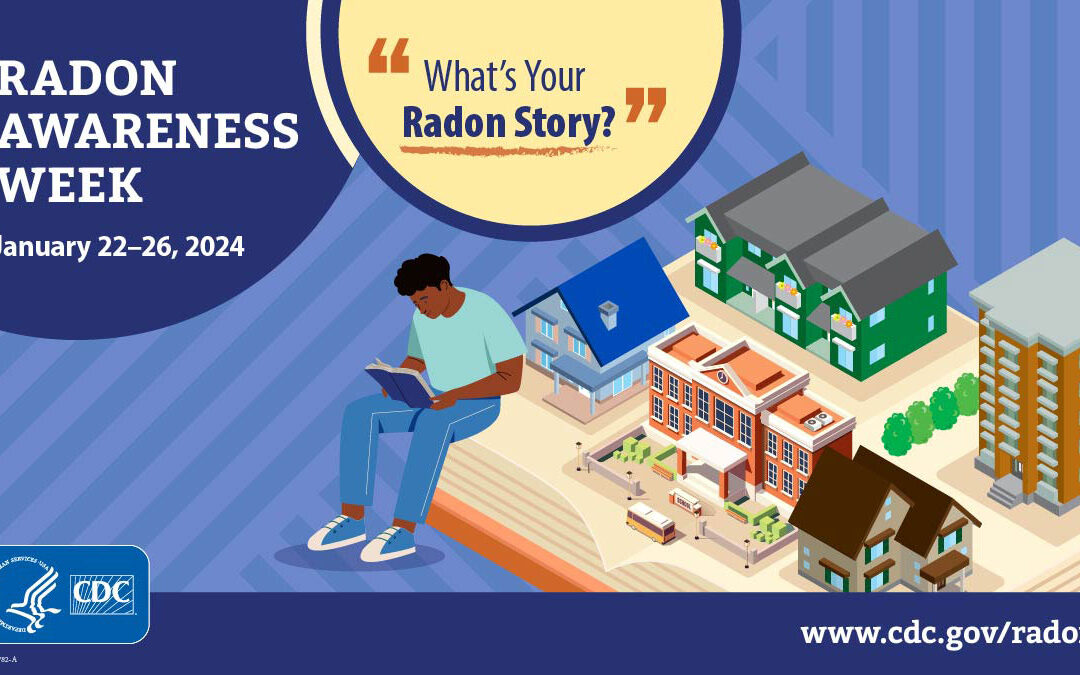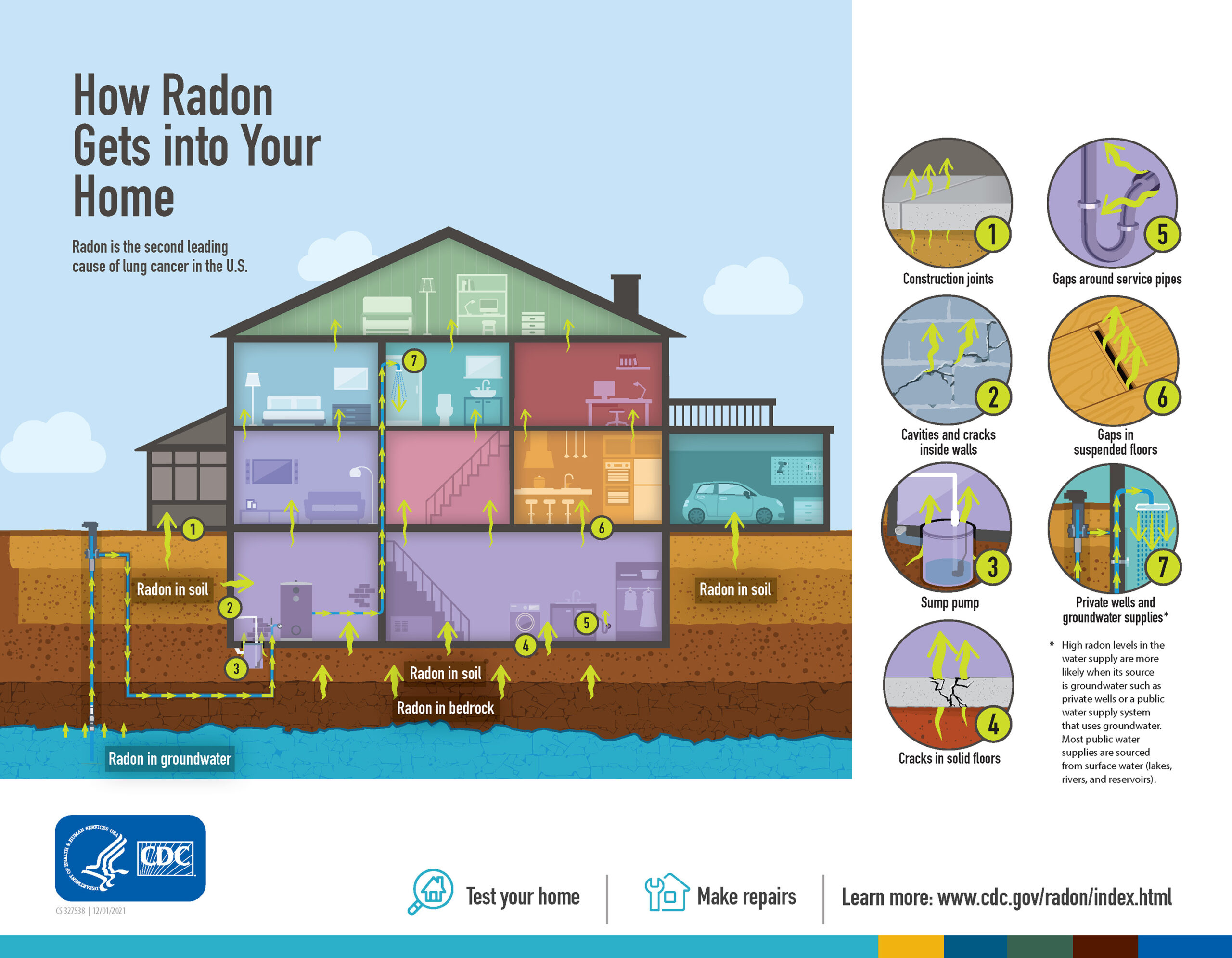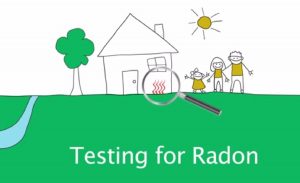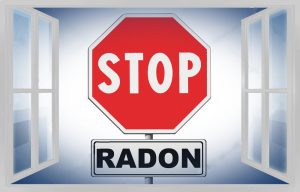The setting is your home and community, where an unseen and silent intruder named Radon poses a threat. You are the protagonist, with your family, friends, and community members playing supporting roles. Together with the heroes of the state radon control officer, radon mitigation contractor, and healthcare providers, the story can have a happy ending if you test and, if necessary, reduce radon levels in your home.
By spreading awareness about radon, you can also become a hero in someone else’s story. Don’t forget, that January 22-26, 2024 is Radon Awareness Week.
Get the Facts on Radon
Radon, an invisible and odorless radioactive gas naturally emitted from rocks, soil, and water, can become trapped within homes and buildings, leading to a buildup in the air. Prolonged exposure to elevated radon levels can significantly increase the risk of lung cancer over time.Radon in Homes and Buildings
All indoor and outdoor environments naturally contain varying levels of radon. In addition, certain construction materials may also emit low amounts of radon. It’s important to note that radon can accumulate in any type of home or building, regardless of whether it has a basement, is tightly sealed or drafty, or is old or new. Since there isn’t a recognized safe level of radon, it is always advisable to strive for the lowest possible level. The U.S. Environmental Protection Agency (EPA) recommends taking corrective action if radon levels exceed 4 picoCuries per liter of air (pCi/L) in your home.
Lung Cancer Risk
Radon, the second leading cause of lung cancer deaths in the United States after cigarette smoke, poses a significant threat to our health. According to the EPA and the Surgeon General’s office, radon is responsible for over 21,000 lung cancer deaths annually in the United States. When we inhale radon, our lungs become a trap for radioactive particles released during its decay. It is crucial to acknowledge that lung cancer takes years to develop, often reaching an advanced stage before symptoms manifest, making treatment more challenging. To safeguard against this devastating disease, it is imperative to prioritize reducing radon exposure throughout our lives. Taking proactive measures can significantly decrease the risk of developing lung cancer.
Factors that increase your risk of getting lung cancer from radon include the following:
- High radon levels in your home or another building that you regularly spend time in
- High radon levels in the part of the home or building where you spend the most time (Radon levels are often higher in basements and lower levels.)
- Smoking cigarettes, currently or in the past
- Burning wood, coal, or other substances that add particles to air
Children can have higher doses of radon than adults, even when exposed to the same radon levels for the same duration. This discrepancy arises from the fact that children possess unique lung shapes and sizes, as well as faster breathing rates.
What You Can Do
Steps you can take to measure and reduce radon levels include the following:Test Your Home
The only way to know if you have unsafe levels of radon in your home or office is by testing. You can contact your state radon office for testing, purchase a test kit in a hardware store or online, or hire a certified Radon Tester.
Fix Your Home
If your radon test shows that radon levels are above 4pCi/L or you are interested in reducing radon in your home, contact your state radon office to help you find a qualified or state-certified radon contractor in your area to fix your home.
Ways to Keep Radon Levels Low
Since there is no safe level of radon, reducing radon within your home or building will always contribute to lowering your risk of developing lung cancer, even if the radon level in your home is below 4 pCi/L.
The U.S. Department of Housing and Urban Development provides valuable recommendations to help minimize your risk of lung cancer and effectively lower radon levels in your home:
- Increase air flow in your house by opening windows and using fans and vents to circulate air. However, natural ventilation in any type of house is only a temporary strategy to reduce radon.
- Seal cracks in floors and walls with plaster, caulk, or other materials designed for this purpose.
- You can cover the earth floor in crawl spaces with a high-density plastic sheet. A vent pipe and fan can be used to blow the radon from under the sheet and vent it to the outdoors
Always retest radon levels after making any changes to ensure that these actions have successfully lowered the radon levels.
Smoking and second-hand smoke, when combined with high radon exposures, significantly increase the risk of lung cancer. To prevent lung cancer, refrain from smoking yourself and prohibit others from smoking in your home.
Buying a New Home
Ask the homebuilder about radon-resistant construction techniques when purchasing a new home. Incorporating these features during the construction process is typically more cost-effective and less complicated than retrofitting them later on.
If you’re buying an already built home, request the seller to perform radon testing by a certified radon professional prior to buying the home. In some Maryland counties, it’s the law to require home sellers to test for radon and perform any radon mitigation prior to closing on a home.
Workplaces, Schools, and Other Buildings
EPA offers valuable guidance and resources to help schools, daycare and childcare facilities, and workplaces in your area effectively reduce radon levels. Connect with your state radon office for comprehensive information on testing and a range of proven reduction strategies.





